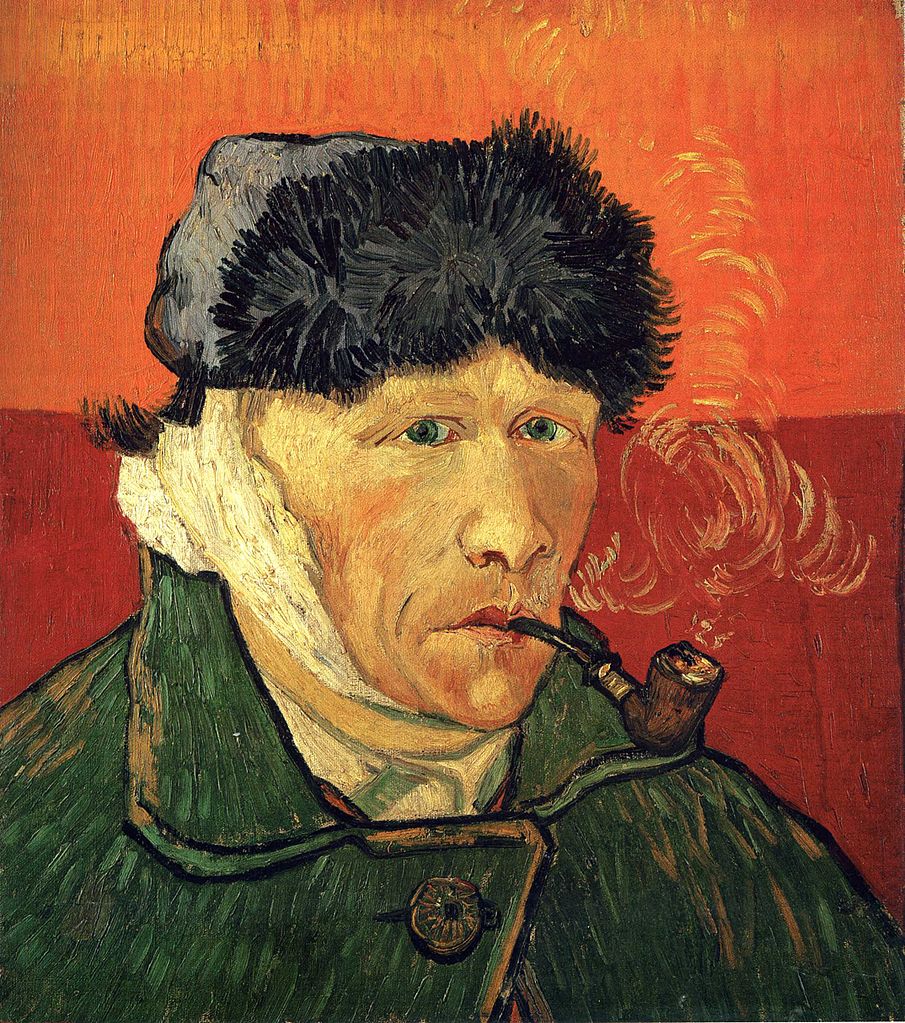Vincent Van Gogh was an admired artist, who was also a troubled and “tortured genius.” His artwork, Starry Night, Bedroom in Arles, and many others have earned him fame and recognition as one of the greatest artists of his time. But what many remember most about this artist is the story of his severed ear. Although his art is exemplary, his struggle with mental health and self-harm is admirable. His struggle was overlooked due to his incredible talent. He was successful as an art dealer, but as an artist, he had to prove himself with the headquarters of international art dealers, Gopil & Cie. During his lifetime, Van Gogh was the poster boy for the image of starving artist. His artwork was not recognized until much later in his career, which could have been a leading cause of his major depression and anxiety.1
Van Gogh, born in the Netherlands, decided to start his career in Paris in the 1880s, where many of the age’s great artists also resided. He believed he could get recognition for his pieces through his younger brother, Theo, who made his living as an art dealer. His brother introduced him to many artists, including Georges Seaurat, Camille Pisatto, and Paul Gauguin. Upon meeting these successful artists, Van Gogh was greatly inspired by their work and began creating his own artistic style, beginning in 1883. Later the same year, Van Gogh rented a small house in Arles, in the south of France. Paul Gauguin and Van Gogh became close friends and later roommates. They consistently bounced ideas off of each other and created a strong friendship.2

Like many friendships, theirs was rocky, and they found themselves drifting apart. Gauguin had moved on to a different artistic style and was exploring other ideas. Van Gogh at the time, had been reciprocating signs of depression and mental health issues, but at the time, these symptoms were considered normal. When Gauguin decided to explore other art spectrums, it involved moving out of the house he and Van Gogh shared. He broke the news to his roommate about his intentions, and this evidently this made Van Gogh go over the edge. He did not take the news lightly and both men began verbally arguing. Van Gogh had disappeared for a few hours and when he returned to confront Gauguin, he had a razor blade in hand threatening to hurt Gauguin.3
During the confrontation, however, Van Gogh was hesitant to hurt his friend and decided to turn the blade on himself and completely cut off his ear. Gauguin left him bleeding and alone. Van Gogh bandaged his head and began drowning himself in alcohol. During this episode, he walked out of his home and into the streets where he found a prostitute. The ear that he had severed off of himself had been neatly wrapped in a cloth; since Van Gogh was still heavily intoxicated, he decided to present this token to the prostitute. Patiently, she ran off and alerted the police about her encounter and they immediately rushed to his home.4
Shortly before Christmas Eve, Van Gogh was found by police in his bed, partially conscious and with major blood loss. Authorities rushed him to the hospital where he surprisingly recovered. Meanwhile, Gauguin was brought into questioning, but gave no testimony on the incident. It was believed that Van Gogh had suffered a severe mental breakdown long before he had severed his ear, but that this created a ripple effect that led to lunacy. The real reason behind the infamous Van Gogh ear-cutting may never be known; Gauguin had promised Van Gogh a pact of silence on the situation in letters that they supposedly exchanged. 5

After the incident, Van Gogh was admitted into a psychiatric facility in hopes of recovering mentally and physically. The dramatic change was not helpful for such a troubled artist, and in July of 1890, Vincent Van Gogh ended his life with a revolver. Before his suicide, however, he created a very iconic painting, Self Portrait with Bandaged Ear 1889. Van Gogh intended to persuade his doctors that he was perfectly able to continue working and creating art by creating this self portrait. He presented his piece, leaving a trail of wonder for his supporters as to why he included certain details in this particular piece, mainly because he continued to paint himself in the same yellow house he and Gauguin shared. Doctors overlooked these details and allowed Van Gogh to leave the facility.6
The epidemy of many artists like Van Gogh is often associated with mental instability, drug use, and alcohol abuse. Van Gogh had an array of medical issues that were tied back to his coping mechanisms (alcohol abuse), and as a result, many did not understand the struggles he faced and degraded him as a person while idolizing his artistic talent. As said before, the real reason behind his mutilated ear will be unclear, but his work and talent will continue to inspire and educate.
- Adam Gopnik, “Van Gogh’s Ear,” The New Yorker, Literature Resource Center (January 4, 2010): 48. ↵
- “Who Really Cut Off Van Gogh’s Ear?” Weekend All Things Considered, Literature Resource Center, (May 2010). ↵
- “Who Really Cut Off Van Gogh’s Ear?” Weekend All Things Considered, Literature Resource Center, (May 2010). ↵
- Belinda Thomson, “Comparing lives: issues of balance in biographical writing,” Literature Resource Center, French Politics, Culture and Society 24, no. 2 (2006): 60. ↵
- Tim Suermondt, “All the Answers.” Literature Resource Ceter, Prairie Schooner 85, no.3 (2011): 47. ↵
- Tim Suermondt, “All the Answers,” Literature Resource Center, Prairie Schooner 85, no. 3 (2011): 47. ↵



170 comments
Iris Henderson
This article was beautifully written. I enjoyed the artwork as well, I am sure very few would disagree. Like many, I knew that Van Gogh had cut off his own ear, however, I didn’t know why he did it. I also didn’t know that he was so close to fellow artist Paul Gaugin. This is one of those articles that opens you up to a subject, that is so intriguing, you just want to find out more!
Kayla Lopez
I have never been intrigued by art or by artists but this title really caught my attention. I have heard a number of different stories about the event that happened that caused him to lose his ear but I had never heard this one before. I never knew about his friend Gauguin or the fact that Van Gogh was hospitalized so I really enjoyed the information presented in this article.
Julian Aguero
I’ve had the privilege to see the original works of Van Gogh at the Art Institute of Chicago. The Institute did such a conveying job in how they set up his collection. His era of depression really spoke out as you strolled through his works. The works that he created seemed more beautiful than they already were once you could see his mental state and the reason his paintings were so truth telling about himself. Van Gogh is not one of my favorite artist but his mind fascinates me.
Constancia Tijerina
I have heard of Van Gogh while in middle school with the small encounter of his mental illness and the most famously known of his self-mutilation of his ear. What I had not know is of his abuse of alcohol and his friendship that had led to his almost fatal moment which then took him straight to the mental hospital. What this article made me feel is pity for poor Van Gogh here who was this amazing and aspiring artist who couldn’t just catch a break to even get noticed for his amazing art he had created. What drove him to madness is true when talked about in the article, he could not figure out why his art wasn’t noticed for so long. It’s sad to think that he had to wait for even after death to get noticed.
Natalia Flores
It’s heartbreaking to hear that someone so talented suffered so much. I believe people do overlook the artist behind the painting or the performer behind the instrument because it’s so easy to be carried off by the image they create. I also think that people in general do not like talking about mental health because of the stigma and image it has and that it is not something pleasant to talk about. We do have to talk about it and it shouldn’t be buried behind a painting or anything.
Edgar Ramon
Vincent van Gogh, although not one of my favorites artists, has a pretty interesting story. I do not think he would have been as famous without his ear story, just because many great artists have not been critically acclaimed without a great story. This post did surprise me however, because I had always thought that van Gogh, gave his ear to a woman that he loved. I did not think it was given to a prostitute, nor did I know that he cut it off because of a quarrel with his room-mate.
Austin Pena
Great article! Ive never knew much about artists’ personal lives, just on the work they have contributed to history. I found it interesting to read that Van Gogh originally cut off his ear due to an argument with a friend, i was unaware of this. Along with that i never knew he gifted his ear to a prostitute, i remember being told he gave it to a woman whom he loved. Even though he suffered with illnesses and eventually took his own life, he has an interesting life and i would’ve wished that he would have continued it into his old age.
Caroline Bush
Art has never been my favorite subject but even I know about Van Gogh and his tragic battle with mental illness. Its sad that a man with such talent and passion had to go through such a difficult battle with himself. I enjoyed that the article expanded on what happened with the ear incident, I never knew that it was because Van Gough was upset because his roommate was leaving. Overall I enjoyed the article and find it tragic that such a talented man went out in such a sad way.
Cheyanne Redman
I am not much into art, I really only know the famous painters, but not their backstories. Van Gogh is work-renowed yet people seem to overlook his mental health. This article does a very good job with presenting his inspiration and how he started his endeavors, and how everything began to pile up leading to his mental health issues. I had no idea he cut off his own ear due to a psychotic episode. This article is extremely interesting and well written by showing all of the elements of his life, the good, bad, and ugly.
Maria Esquivel
At the beginning when you talked about “The Starry Night”, I knew exactly what painting but I never knew it was by Van Gogh. You provided a very detailed glimpse of his life and the way he struggled with alcohol abuse and mental illness. I never knew Van Gogh had cut off his ear but it was interesting to learn about. Although, Van Gogh had a troubled mind he produced some of the world’s most beautiful artwork.